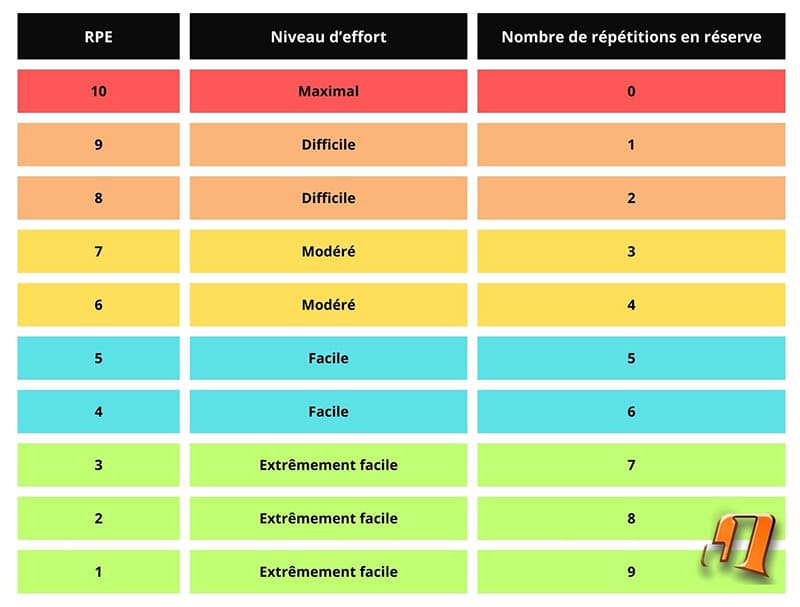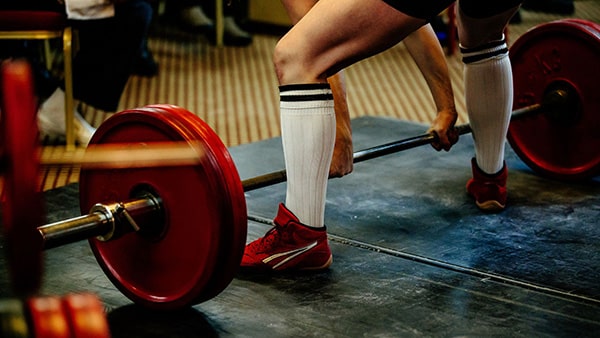En musculation, l’intensité que vous mettez dans chaque séance conditionne vos progrès. Mais comment mesurer cette intensité ? Comment savoir si vos efforts sur une série de squat ou de développé couché sont plus ou moins importants que lors des entraînements précédents ?
C’est précisément le rôle du RPE, un indicateur utilisé par de nombreux athlètes et coachs sportifs pour optimiser leur développement musculaire.
Le RPE, en bref :
- Le RPE est un indicateur permettant d’évaluer l’intensité d’un effort en musculation.
- Il se base sur une échelle de 1 à 10 pour mesurer la difficulté perçue d’une série.
- Plus le RPE est élevé, plus l’effort est intense et proche de l’échec musculaire.
- Le calcul du RPE repose sur le nombre de répétitions en réserve après une série.
- Il permet de suivre sa progression en ajustant les charges selon sa forme du jour.
- Le RPE aide aussi à estimer sa charge maximale sur une répétition.
Sommaire
Qu’est-ce que le RPE en musculation ?
RPE : définition
Le RPE (Rating of Perceived Exertion en Anglais) désigne le niveau d’effort perçu lors d’une activité physique. S’il permet aussi de mesurer la difficulté sur des exercices cardio, cet indicateur est aujourd’hui largement adopté par les pratiquants de musculation.
Concrètement, le RPE consiste à donner une note subjective à l’effort fourni lors d’une série. Ce concept s’appuie donc sur un système d’auto-évaluation.
Plus précisément, imaginons que vous ayez pour ambition de soulever 100 kilos, sur 6 répétitions, lors de votre prochaine série de deadlift. Une fois le nombre de répétitions effectué, vous allez devoir donner une note de 1 à 10 à votre effort.
Une note de 1 symbolise un effort extrêmement facile, tandis qu’une note de 10 représente un effort de très haute intensité pour lequel vous n’auriez pas pu faire une répétition de plus. Un RPE à 7 signifie quant à lui que vous auriez pu réaliser 3 répétitions de plus, ou utiliser une charge plus lourde sur le même nombre de répétitions.
Voici le tableau du RPE en musculation. Vous pouvez vous y reporter pour mieux comprendre les différents seuils.

Comment calculer le RPE ?
Il est très simple de connaître votre RPE durant une séance de musculation.
Il vous suffit de partir du nombre de répétitions que vous pensez avoir en réserve à la fin d’une série, puis de le soustraire à 10.
Prenons l’exemple d’un athlète faisant du développé couché aux haltères pour se muscler le haut du corps. S’il considère pouvoir faire 4 répétitions de plus, il conviendra de faire le calcul suivant :
RPE = 10 – 4 = 6
En ce sens, le RPE en musculation n’est pas une notion destinée aux pratiquants débutants. En effet, pour estimer un RPE au plus juste, il convient de se connaître, et donc d’avoir déjà plusieurs mois d’expérience en salle de sport.
Par manque de connaissances sur la manière dont réagit son corps lors d’une séance de muscu, un débutant aura tendance à sous-estimer ou à surestimer son niveau d’effort perçu.

DÉCOUVREZ MON COACHING PERSONNALISÉ
Sculptez le corps de vos rêves en moins de 90 jours.
Les origines du RPE
Il faut remonter aux années 1970 et aux travaux du professeur Gunnar Borg pour trouver les origines du Rating of Perceived Exertion. Ce Suédois a été le premier à concevoir une échelle de difficulté dans le but de quantifier la difficulté perçue d’un effort. Il a donné son nom à son concept, l’échelle de Borg.
Il s’agit d’ailleurs d’un indicateur largement utilisé en milieu médical. Vous avez déjà certainement entendu un médecin demander à un patient de noter sa douleur sur une échelle allant de 1 à 10.
Le RPE en musculation a ensuite été popularisé par Mike Tuchscherer en 2005, un ancien pratiquant de powerlifting ayant remporté les championnats du monde (2009), aujourd’hui coach renommé de force athlétique.
RPE et RIR
Si vous êtes familier des acronymes dans l’univers du fitness, vous aurez donc compris que le RPE est parfaitement complémentaire du RIR (Reps In Reserve, ou répétitions en réserve en Français).
Le RIR représente le nombre de répétitions additionnelles qu’un sportif pense pouvoir faire pour atteindre l’échec musculaire.
Comme nous l’avons vu précédemment, un RIR de 4 signifie que vous avez un RPE de 6.
N’oubliez pas de prendre un temps de repos suffisant avant de commencer la série suivante.
À quoi sert le RPE en musculation ?
À suivre votre progression
Que vous soyez dans une phase de prise de masse ou de perte de poids, le RPE vous aidera globalement à suivre votre progression en matière de pratique de la musculation.
Gardez à l’esprit qu’un programme de musculation n’est jamais linéaire. Il est impossible de mettre en place une surcharge progressive et d’améliorer vos performances (augmentation des charges ou du nombre de séries, diminution du temps de récupération, etc.) en continu chaque semaine.
Le RPE va ainsi vous permettre d’ajuster vos poids selon votre forme du jour, tout en ayant un suivi précis de vos performances et en ne se limitant pas aux chiffres des charges utilisées.
Prenons cette fois l’exemple d’un athlète qui fait 5 répétitions de soulevé de terre à 100 kilos, RPE 7, lors de son premier entraînement. La semaine suivante, il fait 5 répétitions à 105 kilos, mais cette fois avec un RPE 10.
Certes, il a gagné 5 kilos sur la barre, mais pour un RPE beaucoup plus élevé. Cela permet donc de nuancer la progression.

À estimer votre 1 RM
De plus, le RPE est aussi un excellent moyen de connaître votre 1 RM. Il s’agit de la charge maximale que vous pouvez utiliser sur une seule répétition d’un exercice donné.
Si vous faites une répétition à 100 kilos au squat, avec un RPE de 9, vous savez que vous pouvez augmenter légèrement votre charge. Votre 1 RM se situe donc certainement aux alentours des 105 kilos. Consultez cet article pour en savoir plus sur le calcul du 1 RM.
À faciliter les échanges avec votre coach sportif
Si vous êtes accompagné par un coach de musculation, de force athlétique ou d’haltérophilie, le RPE est un bon outil de communication.
Grâce à cette information précise sur le ressenti du pratiquant, l’entraîneur pourra ainsi ajuster le contenu du programme sportif. Il sera alors plus aisé d’atteindre l’objectif visé : croissance musculaire, perte de gras, gain de force, etc.

Les limites de cet indicateur
S’il est un outil efficace pour gagner du muscle, le RPE n’en reste pas moins un indicateur subjectif. C’est sa principale limite.
Même après plusieurs années passées à faire de la musculation, il peut être difficile d’estimer la difficulté d’un effort fourni.
Et si vous avez cette capacité, le plus dur est certainement de savoir faire preuve de sincérité sur votre ressenti. Le simple fait de surévaluer ou de sous-évaluer votre effort peut mettre à mal votre planification et limiter vos progrès sur le long terme.
Conclusion
Le RPE est un outil conçu pour mesurer la difficulté d’un effort. Que vous vous entraîniez 3, 4, 5 ou 6 fois par semaine à la salle de musculation, c’est un indicateur utile qui vous aidera à améliorer vos performances.
Bien utilisé, il vous permettra d’adapter vos entraînements pour favoriser une progression durable.
FAQ
Le RPE (Rating of Perceived Exertion) est une échelle de 1 à 10 qui permet d’évaluer l’intensité d’un effort en musculation.
Soustrayez le nombre de répétitions que vous pensez pouvoir encore faire à 10. Par exemple, si vous pouvez faire 3 répétitions de plus, votre RPE est de 7.
Le RPE aide à ajuster les charges en fonction de sa forme du jour et permet un suivi précis de la progression.
Non, car il nécessite une bonne connaissance de son corps et de ses capacités pour être évalué correctement.
Le RIR (Reps In Reserve) indique le nombre de répétitions restantes avant l’échec, tandis que le RPE mesure l’intensité perçue d’un effort.
Oui, un RPE élevé sur une répétition permet d’estimer sa charge maximale (1 RM) avec plus de précision.






